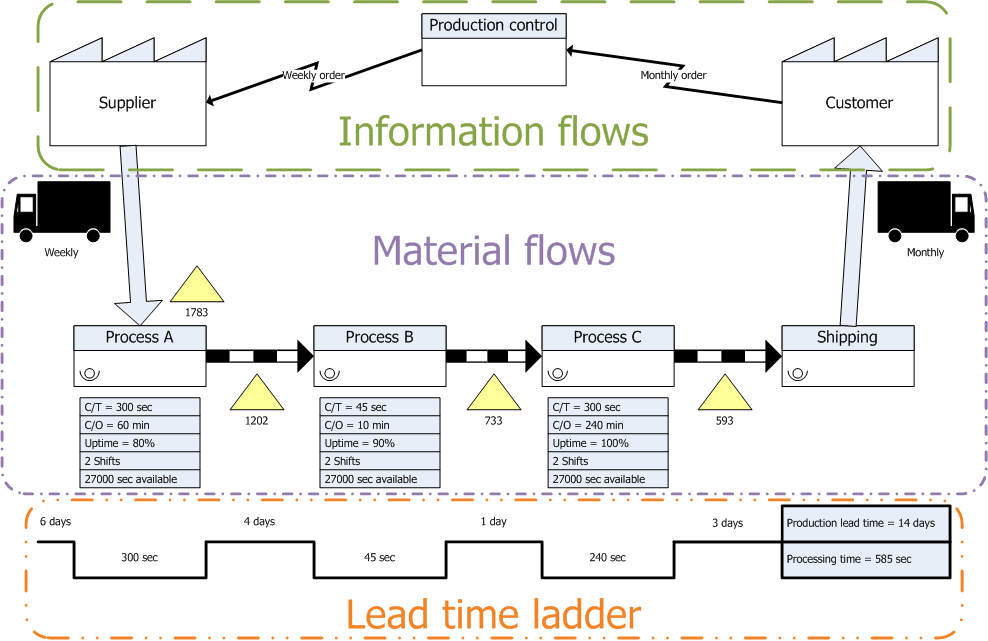Value Stream Mapping
Introduction to Value Stream Mapping (VSM)
VSM – We live in a world that is becoming smaller every day. No, the earth is not shrinking but with the continuous advances in communications and world commerce, parts and products can and are being sourced from all across the globe. Reducing cost is imperative if an organization is going to remain competitive and not only survive but also thrive. We must look for ways to do things more efficiently with less waste. We must make sure that everything we do adds value to our products or services. Lean initiatives are currently active in various industries and organizations. For a lean initiative to be successful, we must be able to measure and quantify improvement. Value Stream Mapping (VSM) is an indispensable tool in the Lean toolbox that can bring a new level of clarity to your processes. By mapping a process we can gain a better understanding of the work being performed, which processes or process steps are actually adding value, and which are creating waste.

What is Value Stream Mapping (VSM)
Value Stream Mapping is a form of process mapping used to document, analyze and improve the flow of materials and information required to produce a product or provide a service. Value Stream Mapping defines and illustrates the sequence of activities and the flow of materials and resources required to produce a product or provide a service. There is some confusion between Process Mapping, or Process Flows, and Value Stream Mapping. While both are useful, there is a significant difference in their format, level of resolution, focus, and application. Process Mapping and Value Stream Mapping differ in that Value Stream Maps:
- Are developed at a much higher level than process maps/flows
- Display a broader range of information that looks at the entire manufacturing process from receiving raw material and purchased components all the way through to the finished product and delivery to the customer
- Include the flow of data and other information through the process
- Include information regarding cycle times and resources required at each operation
- Allows the team to calculate the value added by the process
- Can identify waste in the overall process and determine where to focus future improvement projects (or Kaizen events)
Value Stream Mapping is most often associated with manufacturing processes. In reality, it is currently being utilized in logistics applications, software development, office processes, healthcare, and other service-related industries.
Why Implement Value Stream Mapping (VSM)
In almost every process, there is a certain amount of waste in some form or another. The challenge can be identifying where it is in a process and in what form it exists. The primary benefits of implementing value stream mapping are to help organizations:
- Take an objective look at the overall process, eliminating opinions or conjecture
- Identify and eliminate wasteful activities and learn to prevent waste in future processes
- Gain a new perspective of their operations by examining them at a higher level
No matter how large or successful an organization is, even the best of organizations can become more efficient and more effective. When we go to work each day and make our way through the facility, looking at the same processes and workstations we gradually gain a certain perspective. We tend to miss things because we may have become blind to possible waste or opportunities for improvement. Sometimes we need a different perspective.
By using Value Stream Mapping, we can gain a different perspective of our facility and the flow of material, people, product, and information through the facility. Value Stream Mapping is kind of like looking at your facility and process and flow from several hundred feet above – it is a method of getting the bigger picture.
How to Implement Value Stream Mapping (VSM)
There are actually four steps in the Value Stream Mapping Cycle. They are as follows:
- Create a Current State Map
- Identify and Eliminate Waste in the Process
- Create a Future State Map
- Implement the Future State Map
When you consider the process above, it is actually a circle because once the future state map is implemented it becomes the current state map. In the future, you may begin the cycle again. This explanation will concentrate on the creation of the Current State Map.
Creating the Current State Map
When creating a Current State Value Stream Map, you must document what is actually happening in the process. At this point, we are not concerned with how the process is supposed to work. We are not trying to create a perfect state map, but simply a map that depicts reality. Later we can examine it and look for methods to improve. For now, we want just the facts.
System of Symbols
Before we can begin the construction of a Value Stream Map, we need to cover the symbols used. Value Stream Mapping utilizes a set of symbols or icons that depict the activities, workstations, or process operations, along with the material and the information flowing through the process. There are multiple variations available for use depending upon your application.
Getting Started
Depending upon the size and complexity of your process you can walk the process as a group or divide it into teams to map certain aspects of the process. You must define the boundaries of your process. This will help prevent scope creep and keep the team focused on the goal. The team(s) can come together later and combine the maps into one complete value stream. It might be a good idea to draw your map(s) on paper first because changes will be made and information added during the mapping process. When the map is complete and ready to share with management you may always transfer it to a software application
Walk the Process and Collect Data
It is very important to familiarize your team with the general flow of material and information along with the work stations involved with the process. Start with the “end customer” and walk the process backward. During the walk observe the process, ask questions and collect data as you move through the process. Some examples of data you should gather are as follows:
- Amount of WIP
- Number of operators at each station
- Cycle Times for each operation
- Downtime or time for changeovers
- Amount of scrap or rework
- Inspection or testing time
- Look for the three forms of waste
It is also beneficial to calculate your Takt time for comparison to the actual process time once the VSM is complete. Calculate Takt time by dividing the net available production time by the customer demand. The Takt time is the rate at which the customer actually demands a product.
Define the Process Steps
Work your way through the process of identifying the flow of materials first. Document each of the process steps, adding all the process boxes, data boxes, and completing all the data. The data boxes generally contain information regarding a number of operators, machines, cycle times, etc. Next, identify the inventory and any waiting times. These are the triangles with an “I” in the middle. To document the inventory, count the number of parts between the processes and note them under each of the triangles. In some cases, you may want to convert the inventory numbers into days’ supply. Simply divide the number of pieces by the average daily demand.
Define the Flow of Information
In addition to the material flow value, Value Stream Maps also include the flow of information through the entire process. At this time, you should add the production control box to the map. It is common to have multiple information streams within the process. There are two basic types of information flow identified within the VSM. A straight line represents manually distributed information and a line resembling a lightning bolt represents electronic information. While completing the VSM, include both types of information and how they flow between the various departments and processes. Furthermore, it is good practice to identify what information is being utilized. This could include information from the suppliers to the facility, order information from the customer, as well as production planning information, and shop-level work orders.
Complete the Timeline and Calculate PCE
Next, add the timeline to the bottom of the Value Stream Map. The timeline allows us to separate the value-added cycle times recorded in the data boxes from any non-value added time (Inventory time). The final step in the development of the VSM is to add all the “value-added” cycle times together and enter the sum in the box at the end of the timeline. In the same manner, add all of the “non-value-added” times together and enter the sum in the box at the end of the timeline. You can then calculate your Process Cycle Efficiency (PCE). This is calculated by dividing the value-added time by the Production Lead-Time (PLT). Inventory time is equivalent to PLT.
Once you have completed the Current State Map you have only taken the first large step in the VSM process. Next, you should analyze the Current State Map and identify waste and opportunities for improvement of the process. Review the material and information flow, what process steps are required, and how much inventory is sitting in WIP awaiting the next process. Also, examine the method and types of information flowing through the process. Then determine the actual customer demand for the product and calculate the Takt time. If you are not meeting demand, determine how the process can be improved and then make it happen.
The benefit of Value Stream Mapping is to look at the entire picture for opportunities. Use that new perspective to develop the Future State Value Stream Map and plan improvements. Then follow through and ensure the changes happen. Once all the identified improvements are complete, the Future State Map will become the current State Map and the process can begin again. Remember, the path to continuous improvement is not a straight line but a circle.

